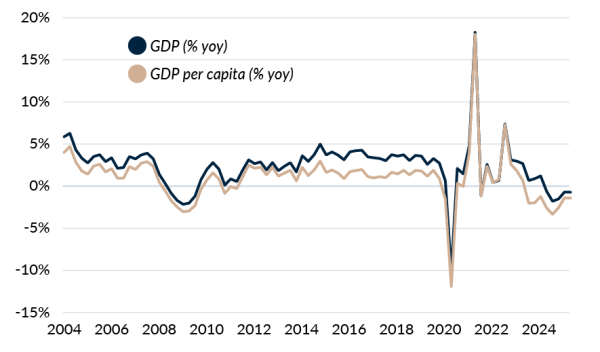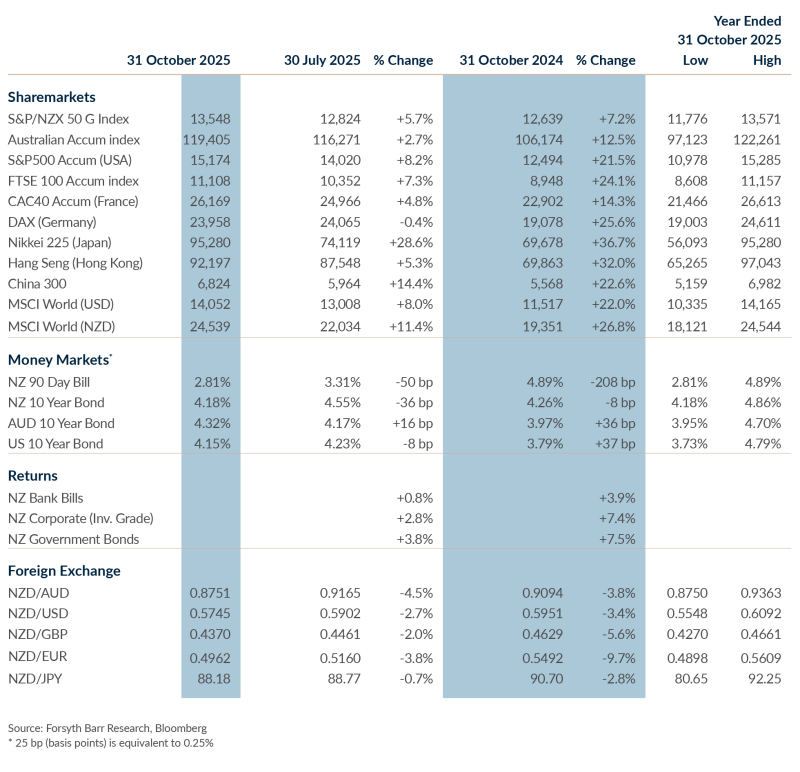
Quarterly Market Comment
As an active fund manager, Octagon Asset Management prioritises high-quality research as an input to decision making. It draws on research from a range of sources, local and global. This includes research provided by Forsyth Barr. Below is its most recent Quarterly Market Comment.
Quarterly Market Comment
For the quarter ended 31 October 2025
- Global equity markets continued to perform well, with the MSCI World Index gaining +8.0% over the past three months. A weaker local currency provided a tailwind, with a return of +11.4% when measured in New Zealand dollars.
- Over the past year, the MSCI World Index has gained +22.0%, again with stronger results in NZD terms of +26.8%.
- Performance across global markets has generally been positive, although to varying degrees across different regions, with the US up +8.2%, Australia up +2.7%, and New Zealand +5.7%.
- Fixed income returns were positive, though more modest. New Zealand investment–grade corporate bonds rose +2.8% for the quarter, bringing 12-month returns to +7.4%.
A healthy quarter for global markets
Global equity markets have continued to deliver strong gains over the past three months. In the US, shares have continued to gain, supported by solid company profits, with earnings guidance for the next few months improving. The Federal Reserve’s recent rate cut is also seen as reducing the risk of a sharper economic slowdown. European markets have risen too, helped by fading trade-war worries, a firmer economic backdrop, and hopes of more government spending.
Looking at US markets in particular, a small group of very large AI-related companies has led markets. That’s fine while they keep delivering, but it leaves markets vulnerable if profits miss or if businesses slow their spending on AI projects. That’s why diversification—spreading investments across different sectors—remains important.
Interest rates have further to fall as New Zealand economy remains sluggish
New Zealand’s economy struggled over the first half of 2025. The economy shrunk ‑0.9% over the June quarter, underscoring a weak domestic backdrop. However, more timely indicators suggest that conditions are beginning to improve as we move towards 2026.
New Zealand GDP growth and GDP growth per capita (% yoy)

There are already pockets of strength emerging across the economy. Agriculture and horticulture are performing well, supported by firm global commodity prices. Fonterra delivered a record NZ$10.16 per kilogram of milk solids for the 2024/25 season, with another payout exceeding NZ$10 likely for the current season. Farmers are expected to use some of this additional income initially to reduce debt. Yet, with another strong year anticipated—and a windfall from the sale of Fonterra’s consumer business—more of this cash is likely to flow through rural communities. Tourism also continues to recover, with international arrivals now around 90% of pre-COVID levels. While the rebound has been slower than in some other countries, the steady increase is helping to underpin regional economies.
By contrast, the picture in Auckland and Wellington has been more downbeat. Weaker construction activity, softer housing markets, and subdued consumer sentiment have kept growth on the back foot. The housing market is particularly impactful—with falling prices tending to sap confidence and suppress spending.
Against this backdrop, interest rates have continued to fall, with the Reserve Bank cutting the Official Cash Rate (OCR) by 50bp at its latest meeting in October, and another 25bp rate cut expected in November. Borrowing costs for mortgages and business loans are easing further, offering some welcome relief to households and companies facing higher repayment burdens.
At the same time, lower rates are impacting savers. Returns on cash and term deposits may fall further, prompting some to reassess whether their money is still working hard enough. With interest rates shifting, now could be a good time to review where your savings are parked—and whether other options might offer a better balance between risk and return.
Australasian reporting seasons mixed
New Zealand’s August reporting season showed ongoing challenges for many companies. Results were uneven, with continued revenue pressure, margin compression, and cyclical weakness. On a brighter note, a number of firms reported that rising costs are moderating and that customer demand is beginning to stabilise. Despite the challenging macro backdrop and mixed reporting season, the S&P/NZX 50 Index has gained +5.7% over the most recent quarter, as confidence builds that the worst is behind us. There is increasing appeal in NZ’s defensive profile of high-quality, dividend-paying companies, particularly as interest rates continue to fall, which is starting to positively impact local stocks.
Australia’s latest reporting season told a similar story of mixed performance across industries, and we have seen solid, albeit comparatively more muted, returns on the ASX 200 this quarter of 2.7%.
Don’t chase the hype
Over the past year, your investment portfolio has likely featured both standout performers and underwhelming laggards—that’s entirely expected. The very purpose of diversification is to ensure that different investments excel under different conditions.
It can be tempting to chase the sectors dominating the headlines, but FOMO (‘fear of missing out’) is rarely a sound investment strategy. By the time a theme has become front-page news, much of the easy money has usually been made and it now may even be overhyped.
Instead, stay focused on your own goals, time horizon, and risk tolerance. A diversified, disciplined approach—reviewed occasionally, not constantly—has historically worked better than chasing short-term hype. Remember: past performance is no guarantee of future results.
Matt Henry
Head of Wealth Management Research
Zoe Wallis
Investment Strategist

Not personalised financial advice: The recommendations and opinions in this publication do not take into account your personal financial situation or investment goals. The financial products referred to in this publication may not be suitable for you. If you wish to receive personalised financial advice, please contact your Forsyth Barr Investment Adviser. The value of financial products may go up and down and investors may not get back the full (or any) amount invested. Past performance is not necessarily indicative of future performance.
Disclosure: Forsyth Barr Limited and its related companies (and their respective directors, officers, agents and employees) (“Forsyth Barr”) may have long or short positions or otherwise have interests in the financial products referred to in this publication, and may be directors or officers of, and/or provide (or be intending to provide) investment banking or other services to, the issuer of those financial products (and may receive fees for so acting). Forsyth Barr is not a registered bank within the meaning of the Reserve Bank of New Zealand Act 1989. Forsyth Barr may buy or sell financial products as principal or agent, and in doing so may undertake transactions that are not consistent with any recommendations contained in this publication. Forsyth Barr confirms no inducement has been accepted from the researched entity, whether pecuniary or otherwise, in connection with making any recommendation contained in this publication.
Analyst Disclosure Statement: In preparing this publication the analyst(s) may or may not have a threshold interest in the financial products referred to in this publication. For these purposes a threshold interest is defined as being a holder of more than $50,000 in value or 1% of the financial products on issue, whichever is the lesser. In preparing this publication, non-financial assistance (for example, access to staff or information) may have been provided by the entity being researched.
Disclaimer: This publication has been prepared in good faith based on information obtained from sources believed to be reliable and accurate. However, that information has not been independently verified or investigated by Forsyth Barr. Forsyth Barr does not make any representation or warranty (express or implied) that the information in this publication is accurate or complete, and, to the maximum extent permitted by law, excludes and disclaims any liability (including in negligence) for any loss which may be incurred by any person acting or relying upon any information, analysis, opinion or recommendation in this publication. Forsyth Barr does not undertake to keep current this publication; any opinions or recommendations may change without notice. Any analyses or valuations will typically be based on numerous assumptions; different assumptions may yield materially different results. Nothing in this publication should be construed as a solicitation to buy or sell any financial product, or to engage in or refrain from doing so, or to engage in any other transaction. Other Forsyth Barr business units may hold views different from those in this publication; any such views will generally not be brought to your attention. This publication is not intended to be distributed or made available to any person in any jurisdiction where doing so would constitute a breach of any applicable laws or regulations or would subject Forsyth Barr to any registration or licensing requirement within such jurisdiction.
Terms of use: Copyright Forsyth Barr Limited. You may not redistribute, copy, revise, amend, create a derivative work from, extract data from, or otherwise commercially exploit this publication in any way. By accessing this publication via an electronic platform, you agree that the platform provider may provide Forsyth Barr with information on your readership of the publications available through that platform.